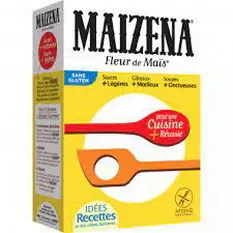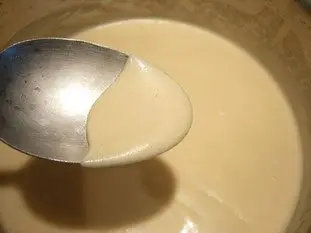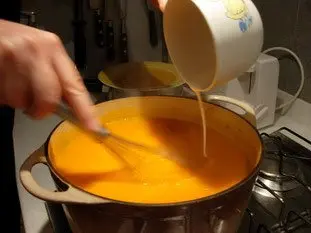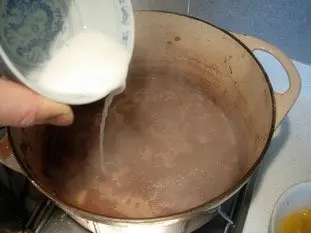This site uses only a few technical cookies necessary for its operation. By continuing to browse, you accept their use.
To find out more...
To find out more...
The super powers of cornstarch

I start this new year by evoking an old product, that you most probably have in your cupboards, a white powder, often in a small cardboard package with a slightly outdated look, only the "gluten free" is relatively recent, it is simply cornstarch, hence its name of maïzena.
It's used for a lot of things, mainly as a thickener in pastry, but it can also, sometimes, work small miracles in the kitchen.
It's used for a lot of things, mainly as a thickener in pastry, but it can also, sometimes, work small miracles in the kitchen.
15 K
Keywords for this post:FlourCornCornstarchThickenerStarchSaucePastryLast modified on: January 14th 2022
The super powers of cornstarch
How does it work?
See what happens when you make a béchamel sauce? It's pretty liquid because of all the added milk, but it heats up slowly while you stir regularly, and suddenly bim! The whole thing thickens and your béchamel is there, thick and creamy.

A simple physical thing happened, the grains of starch in the flour, contained in the roux, finally exploded under the effect of the heat, around 60°C, and immediately absorbed a big part of the milk to form a starch, that's the béchamel.
The link with cornstarch is that it can do the same thing, but as it contains only starch (from corn), its binding power is stronger.
Add to that the fact that it doesn't add any taste, and you have a binder that can be used in many recipes, sweet or savoury, and situations of which here are a few.
Soups and veloutés
When you make a soup (a blended soup) of pumpkin for example, there is sometimes a little problem of texture: it settles, vegetable pulp at the bottom of the pan and water on top.
It doesn't change the taste, but it's not a very pretty or pleasant texture, especially if it's been waiting a while.

Solution : Mix 2 tablespoons of cold water with 2 tablespoons of cornstarch, and incorporate this mixture with a blender or a whisk at the end of the cooking time, you will be amazed by the creamy effect obtained.
Dishes in sauce
When you make a dish in sauce like beef bourguignon, coq au vin, or blanquette de veau, you often need to add flour and cook for a very long time uncovered to obtain a thick sauce. Sometimes, frustratingly, it doesn't even thicken (well).

Solution: Same treatment as for the soup, a tablespoon is enough, added by mixing briskly (whisk, spatula), the neutral taste of cornstarch ensures a thick sauce with an unchanged taste.
You want to prepare a sauce with a deglazing (you pour a liquid, wine for example) of the cooking pan, but without using cream?
No problem, deglaze, bring to a boil and whisk in the cornstarch + water mixture, a large teaspoon is enough. Velvety sauce guaranteed.
Catching up with disasters
You have made a custard, for example, and it has dissociated? All is not lost, add 1 teaspoon of cornstarch + water to the mixer.
Replacing the flour
In some preparations, pastries, creams etc. traditionally made with flour, you can very often replace the flour with cornstarch, because flour, in this context of cooking at low temperature, has a tendency to soften the preparation. That's why pastry cream, almond cream, and even some cookies, will be better and easier to make with cornstarch than with flour.
As you can see, cornstarch is your friend, it's always good to have a pack of it in your cupboards, and it can be used in many ways, mainly as a thickener.
The power of cornstarch again: Make this delicious chocolate cornstarch cream with your kids (less than 5 minutes), you'll have a huge success!

To sum up: Cornstarch is an excellent binder in cooking and baking, it can be used in many recipes, but also to make up for small disasters.
Lasts posts
Butter vs. grease
We often read in a recipe where a pastry is put into a mould that, just before pouring, the mould should be buttered or greased. But what's the difference between these 2 terms?December 1st 20259915
Getting out of the fridge early
Very often when you're cooking, you need to take food or preparations out of the fridge, to use them in the recipe in progress. There's nothing tricky about this: you just take them out of the fridge and use them, usually immediately, in the recipe. But is this really a good method?November 24th 20251,1225
Who's making the croissants?
When you look at a bakery from the outside, you naturally think that in the bakery, the bakers make the bread, and in the laboratory, the pastry chefs make the cakes. It's very often like that, with each of these professions having quite different ways of working, but sometimes there's also one...November 23th 20251,014
Oven height
When we put a dish or cake in the oven, we naturally tend to put it on the middle shelf, and that's what we usually do. But in some cases, this position and height can be a little tricky, so let's find out why.October 8th 20252,7505
The importance of sieving
In recipes that use a fine powder (flour, powdered sugar, etc.), you'll often see the advice to sift before using it. To sift is to pass the powder in question through a sieve (a very fine strainer) before incorporating it into your recipe. It's often advice, but is it really useful?September 3rd 20257,5333
Other pages you may also like
Candied fruits: don't get ripped off
Do you like candied fruit? You might like to nibble a handful or add it to a recipe, like a classic fruit cake or delicious Italian specialities like panettone or sicilian epiphany pie.June 21th 201767 K 24.2
Drawing a pattern in pastry
Often in the kitchen, in pastry-making, or in baking, we need to trace a pattern on a pastry. It's just a question of aesthetics but it has its effect after baking on a galette, pithiviers, pâté en croute (terrine in a pie crust), etc.May 23th 201935 K4.1
The so-called "nervous" meats
You've probably heard this before, we're talking about "nervous" meat, or meat with nerves, to describe what is indicated by the blue arrow on the left. This is a piece of beef, and what we call a nerve is not a nerve, it is in fact collagen (chemists sometimes call it a "collagen sink"), a...April 16th 202137 K4.5
A few tips for effective kneading at home
When you have to knead dough for bread or some other recipe, you may well use a food processor or the type of machine known as a stand mixer. The best-known brands are Kenwood and KitchenAid. They are useful tools, but here are a few tips to help you get the best out of them.June 23th 2021284 K 23.8
Egg yolks and caster sugar
We often come across recipes where we need to mix egg yolks with caster sugar. This would appear to be a very ordinary and simple thing to do but, be warned, these two ingredients can behave oddly together.February 15th 201883 K 24.3
Post a comment or question
Follow this page
If you are interested in this page, you can "follow" it, by entering your email address here. You will then receive a notification immediately each time the page is modified or a new comment is added. Please note that you will need to confirm this following.
Note: We'll never share your e-mail address with anyone else.
Alternatively: you can subscribe to the mailing list of cooling-ez.com , you will receive a e-mail for each new recipe published on the site.









